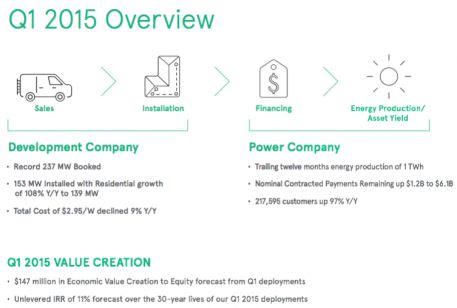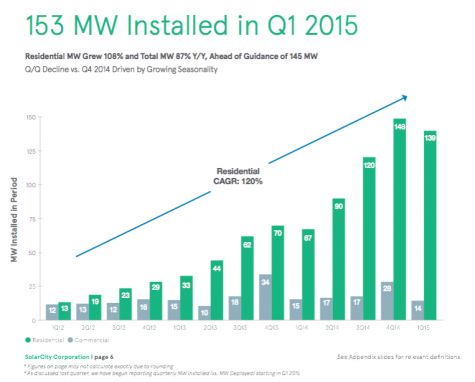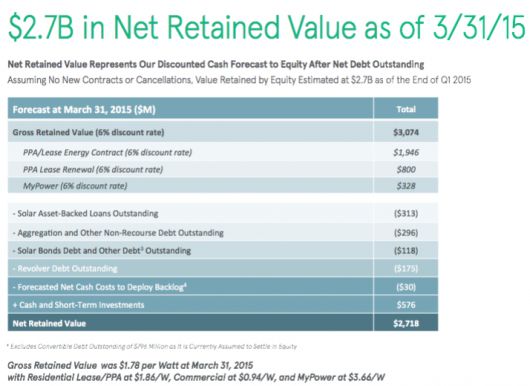In an interview a few years back, Lyndon Rive, co-founder and CEO of SolarCity, bristled at the company being referred to as a solar installer or financier. He insisted that SolarCity is a distributed generation provider and more akin to a power company than a solar installer.
This afternoon, SolarCity posted another strong quarter, added some new key financial metrics, and suggested that SolarCity is more akin to two types of companies -- a development company and a power company. (During the recent Tesla battery gala, CEO Elon Musk intimated that there are two Teslas, the car company and the energy company. Take note.)
SolarCity's development company sells and installs solar and energy storage. The power company provides financing and harvests 30 years' worth of energy production/asset yield.

In Q1 2015, SolarCity, the development company, booked 237 megawatts, a new record, and installed 153 megawatts, exceeding the 145-megawatt guidance.

SolarCity, the power company, has produced over 1 terawatt-hour of energy over the last 12 months and recently broke through the 6-gigawatt-hour-day mark.
Yesterday, SolarCity, the power company, announced that it had closed a $500 million financing aggregation facility with BofA Merrill Lynch, Credit Suisse and Deutsche Bank that is "expected to be the largest of its kind for distributed generation solar projects," according to a release, and is directed at financing more than 500 megawatts of solar power.

A few tidbits from the call
-
COO Tanguy Serra said that to achieve the goal of 1 million customers by 2018, the company must grow 60 percent per year
-
The company now has approximately 218,000 customers
-
It hired 1,300 employees in the quarter
-
Serra noted that a recent 157-kilowatt commercial rooftop install took 3 days due to the use of the Zep mounting hardware. Other installers would take weeks to perform the same job, according to the COO.
-
Blended average Q1 total cost was $2.95 per watt
-
Installation cost was $2.09 per watt, down 14 percent year-over-year
-
Brad Buss, the CFO, suggested that the firm is close to a new asset-backed security issuance and expects to be a frequent participant in this market
-
$3.1 billion of solar energy systems assets are capitalized on balance sheet
-
There are $6.1 billion of estimated nominal contracted payments remaining
-
Net retained value, which is defined as the "net present value of all net customer cash flows forecast over the 30-year lives of the systems after net debt outstanding," was $2.7 billion at the end of the quarter

Energy storage
Jeff St. John has reported on the ways SolarCity or Tesla might make money with new energy storage products. But despite the chatter about rate cases, time-of-day usage, and 50-50 revenue splits, the SolarCity folks on this call are still waiting for the right rate case and for market structures to resolve.
For now, the application is backup power. According to the company, "initial demand for backup gen has been off the charts and way beyond our expectations."
- The Powerwall unit weighs 220 pounds; it has integrated lift handles that allow "two people" to carry it.
- It costs $5,000 to add a Powerwall to a solar lease or PPA
- SolarCity verified that the built-in power electronics consist of a DC-DC converter that provides an isolated high-voltage DC output. The $3,500 price does not include an inverter, "nor the balance-of-system for providing backup power. The inverter is a standalone unit, separate from the Tesla battery. The old architecture was AC-coupled, meaning there were separate inverters for the battery and for the PV. The new architecture can be AC- or DC-coupled. SolarCity will be using a system that is DC-coupled, where a single inverter is connected to both the PV and the Tesla battery."
- According to CTO Rive, "Customers removing themselves from the grid [would be] a bad policy outcome."
SolarCity Q2 and 2015 guidance
-
Q2 2015 megawatts installed: 180 megawatts
-
Full year 2015 megawatts installed: 920 to 1,000 megawatts
Analysis from Baird
-
SolarCity "remains a leader in the U.S. residential market," but "the company will soon introduce 'levered retained value,' which will be optically negative, and we believe the current regulatory environment creates market and headline risk."
-
"We still use retained value and will now use levered retained value to value the stock. SolarCity is expected to introduce its 'levered' retained value metric in the near term. [...] Although new metrics should allow for more accurate valuation, we believe 'levered' retained value will appear optically negative as it will be lower than unlevered retained value."
-
"In the longer term, we believe SolarCity may provide additional metrics allowing for independent valuation of the project development portion of the company (DevCo) and operating portion of the company (OpCo)."
UBS comments on YieldCos and CAFD
-
"We anticipate SolarCity will set the precedent for future earnings releases by solar companies with the announcement of both existing and forecasted CAFD and yield metrics with 1Q earnings. We believe this will be an important turning point for the sector, and as more companies follow suit, comps between standalone YieldCos and SolarCos will become more fluid, irrespective of their decisions to pursue a separate YieldCo structure."
- SolarCity "remains a leader in the U.S. residential market," but "the company will soon introduce 'levered retained value,' which will be optically negative, and we believe the current regulatory environment creates market and headline risk."
- "We still use retained value and will now use levered retained value to value the stock. SolarCity is expected to introduce its 'levered' retained value metric in the near term. [...] Although new metrics should allow for more accurate valuation, we believe 'levered' retained value will appear optically negative as it will be lower than unlevered retained value."
- "In the longer term, we believe SolarCity may provide additional metrics allowing for independent valuation of the project development portion of the company (DevCo) and operating portion of the company (OpCo)."



